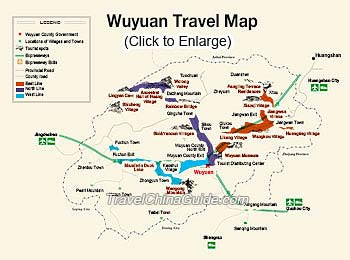Attractions along East Line of Wuyuan
 |
| Click to enlarge it, or go for more Wuyuan Map |
Featuring ancient villages with time-honored residences, profound culture, and wonderful scenery, the east tourist line is the most popular among the three major tourist lines of Wuyuan. There are many distinctive villages on the way threaded by the eastwards minibus from the Wuyuan Bus Station. The wonderful locations and the convenient transport allow tourists to visit them one by one. The must-sees include Likeng (typical water town in Wuyuan), Wangkou (famous for its carving treasury), Jiangwan (hometown of celebrities), Xiaoqi (the most beautiful village), and Jiangling (the best site for appreciating rape flowers). Cycle or walk around the small villages, and spend a night in the countryside inns, you will be refreshed with the enchanting rural scenery, and have a memory of a lifetime.
Suggested Route:
Moon Bay → Likeng Village (Small Likeng) → Wangkou Village → Jiangwan Village → Huangling Village → Xiaoqi Village → Jiangling Village → Qingyuan Village → Wulongyuan Driftage → Guankeng Village
![]() Moon Bay
Moon Bay
Moon Bay, shaped like a crescent moon, is about 1.5 miles (2.5 kilometers) away from Wuyuan County. Taking the mini bus from Wuyuan County, Moon Bay is a scenic spot passed on the way to Likeng Village. When the weather is good, it’s worthy of a stop for keen photographers to take impressive pictures.![]() Likeng Village
Likeng Village
Likeng Village, also known as Small Likeng, was built in the Northern Song Dynasty (960-1127) and is the closest scenic area away from the county. Tourists can activate the combo tickets in the entrance of this village. Because of its convenient transportation, Likeng Village is well-developed and has excellent tourist facilities.![]() Wangkou Village
Wangkou Village
Wangkou Village, regarded as a“Chinese Folk Cultural Village”, features exquisite Huizhou wood carvings. Besides, it’s a good place for tourists to taste special farmhouse meals.![]() Jiangwan Village
Jiangwan Village
First built in the Tang Dynasty (618-907), Jiangwan Village is referred to as a“Town of Literati”. In ancient times, it was a quite important fortress protecting both land and water traffic, at the conjunction of Anhui, Zhejiang, and Jiangxi Provinces, so it was called the East Gate of Wuyuan.![]() Huangling Village
Huangling Village
With the biggest characteristic “Dry Crops”, Huangling Village is in the shape of “U”. Unlike other scenic spots, the special experience to be had in the village is the cable car to the mountain top. Viewing the scene of the entire year’s produce drying in the sun while riding in the cable car will leave tourists with a memorable impression.![]() Xiaoqi Village
Xiaoqi Village
Featuring well-preserved ancient buildings and ecological tea gardens, Xiaoqi Village is divided into the Upper Village and Lower Village. These two villages are connected by an ancient bluestone path. Radiating tracks left by ancient Huizhou merchants’ carts are a relic of the flourishing period of Xiaoqi Village. ![]() Jiangling Village
Jiangling Village
Being 14 miles (21.9 km) away from Xiaoqi Village, Jiangling Village is the most important scenic spot on the east tourist line. Featuring large scale terraces and an ocean of golden rape flowers, tourists can become addicted to the amazing scenery. A well-known photograph of this village named “Heaven on Earth” had once won the gold award of an international photo competition.![]() Qingyuan Village
Qingyuan Village
First built in 674 during the Tang Dynasty, Qingyuan Village is located at Duanshen Town, the northeastern part of Wuyuan. It is cited as “Shangri-la” famous for its beautiful natural scenery and exquisite ancient buildings.![]() Wulongyuan Driftage
Wulongyuan Driftage
Wulongyuan Driftage, 27 miles (45 km) from the center of the county, has an abundance of aquatic attractions. Passing peaceful terraces, valleys, and ancient villages, the driftage has a length of 5.3 miles (8.6 km) and a total drop of 977 feet (298 meters). The water channel can be divided into three parts. The upper and lower parts have large gaps and turbulent water, while the central section is calm.![]() Guankeng Village
Guankeng Village
Located at Duanshen Town, Guankeng Village is famous for its beautiful natural scenery, abundant cultural relics, and fascinating legends. A Y-shaped river divides the village into three parts. In the innermost part of the village, two branches of the river come together and flow into a lake in the mountain. Tourists can walk along the bluestone path by the river to enjoy the delightful scenery.